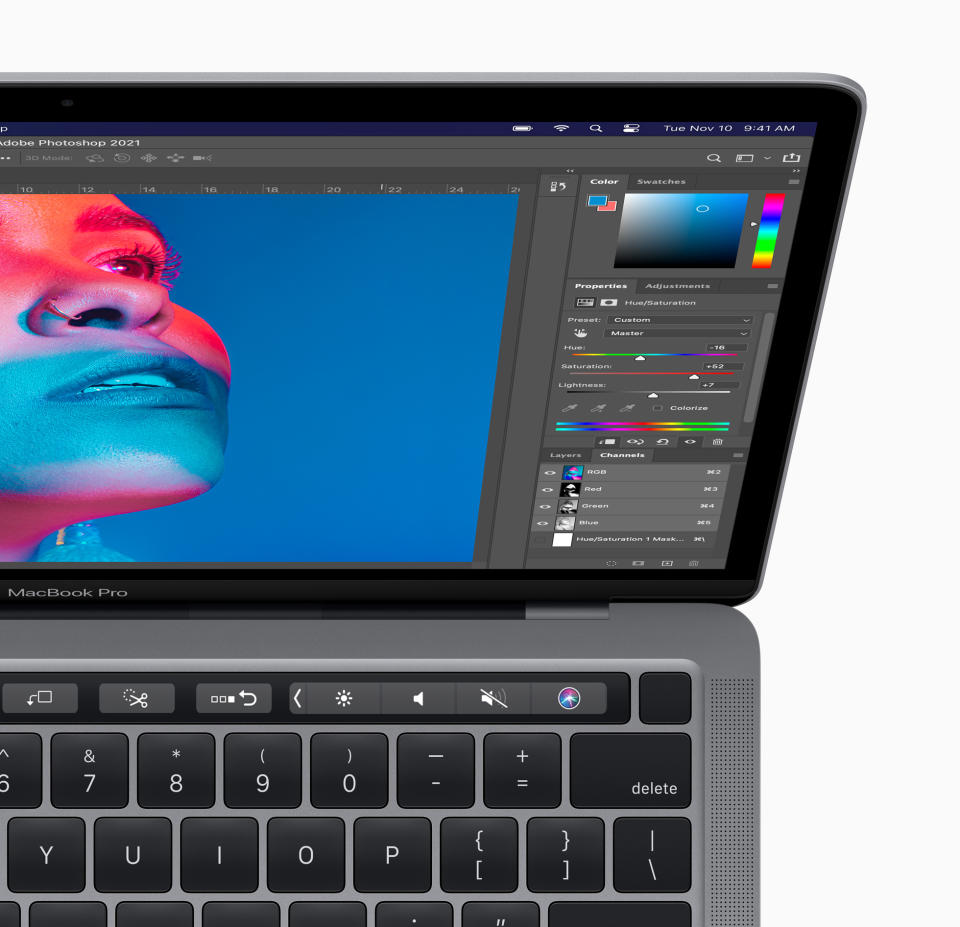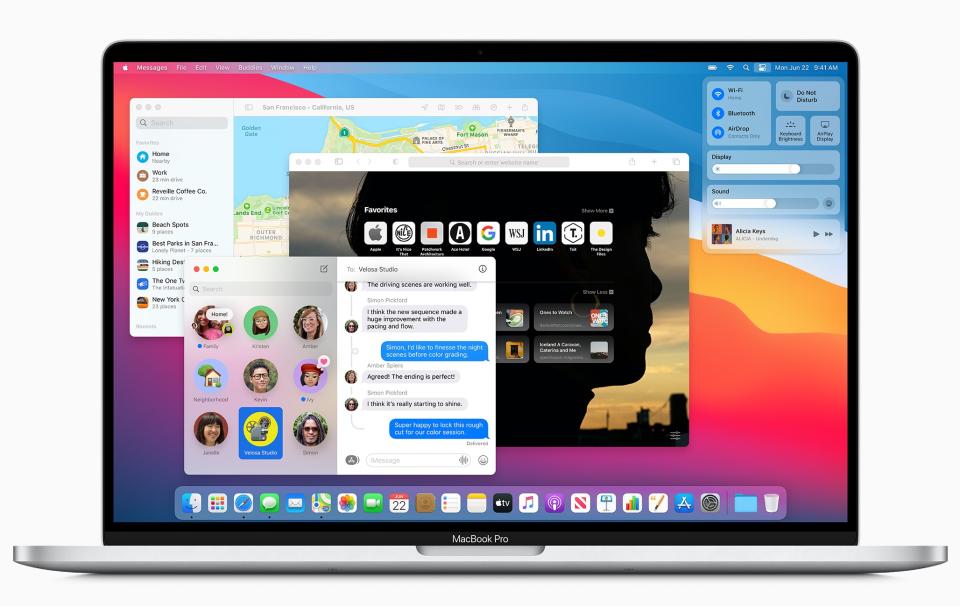Apple announces its first-ever M1 processor, coming to MacBooks and Macs
Apple (AAPL) on Tuesday debuted its first line of Macs running on its own custom processors. The MacBook Air, 13-inch MacBook Pro, and Mac mini, which launch next week for $999, $1,299, and $699, respectively, represent a big step for the tech giant.
Rather than relying on the Intel (INTC) chips that have powered its Mac line for the last 14 years, the company is now delegating the task to the same kinds of processors that run its iPhones and iPads.
Not only does the move give Apple greater control of its devices by developing more of the hardware that powers them, it also means that the firm will be able to create software that runs as smoothly on its computers as it does on its smartphones and tablets, including the very same apps.
Here’s what we know about the new Macs so far, and what you can expect.
Apple’s new M1 chip
Apple’s latest systems are powered by the company’s new ARM-based M1 chip. Featuring an 8-core CPU, and 8-core GPU, Apple says that the chip is its most advanced ever built, and offers three times the performance per watt than prior generation chips. That essentially means that Apple’s chips are able to handle more intensive tasks without devouring all of your laptop’s power.
As for the GPU, Apple says it offers two times the performance of the leading PC processor’s. That, however, doesn’t mean Apple’s chip can stand toe-to-toe with Nvidia or AMD’s dedicated graphics chips, only that it can take Intel’s own built-in graphics chips to task.

How does the company do that all? By transitioning to a 5-nanometer processing technology, which packs in the largest number of transistors Apple has put in a chip. That’s far more advanced than Intel’s current 10-nanometer technology, and even the 7-nanometer processors used by AMD.
The new MacBook Air
According to Apple, the new M1-powered MacBook Air offers five times the graphics performance of its previous generations, meaning you can do things like edit multiple streams of 4K video at once, which is a massive jump. In fact, Apple claims the new Air is 3X faster than the best-selling Windows PC on the market.

It’s not just the CPU and GPU that are faster though, Apple says the Air’s solid-state storage drives are now two times faster thanks to the M1, so you won’t have to wait long to open super-high resolution photos or videos.
Impressively, the new MacBook Air is also fanless, so you won’t hear an annoying whine when you’re pushing it to its limit. As for battery life, Apple says you’ll get 15 hours of web browsing and 16 hours of video playback time. That’s six hours more than before. And for our current, virtual world, Apple says the Air gets two times the battery performance with video calls.
On that note, Apple has also added its latest image signal processor to the Air, so you’ll get better image quality from its FaceTime camera.
The new 13-inch MacBook Pro
Apple has also outfitted its 13-inch MacBook Pro with its new M1 chip. The upgrade means that the Pro gets 2.8 times faster CPU performance and a whopping five times faster GPU. The company says that means developers will be able to build Xcode apps three times faster than ever before.
Apple says the Pro is 3x faster than the best-selling Windows laptop in its class, and can play back 8K video footage without any frame rate issues. As for machine learning capabilities, Apple says the Pro is 11 times faster than the previous generation system.

Unlike the Air, the Pro does come with an active cooling system, meaning it has a fan built in. But it also gets 17 hours battery life while browsing the web using a wireless connection and 20 hours of video playback. That, according to Apple, means the Pro has the longest-ever lasting battery found in a Mac.
Like the MacBook Air, the Pro also gets an improved image signal processor for better video calls. It also gets studio quality mics, for better audio capture.
The new Mac mini
Finally, Apple is bringing the M1 chip to its Mac mini desktop. The pint-sized powerhouse will see 3 times the CPU performance of the previous quad-core system, and 6 times the graphics capabilities. Apple says that will allow users to design games using the popular Unity graphic engine and play games like “Baulder’s Gate 3.”
The company went on to say that the mini will provide 5x better performance than the best-selling Windows laptop on the market at just one-tenth its size. That’s a big statement, and one we’ll be sure to follow up on.
Big Sur and mobile apps
Powering those three Macs is Apple’s latest version of its macOS operating system: Big Sur is designed for use with the M1 chip. macOS Big Sur includes a new design and updates for apps like Safari and Messages. And since Apple has designed both the hardware and software, it can now take advantage of features found on the iPhone and iPad like being able to wake a device from sleep instantly.
Apple's senior vice president of software engineering Craig Federighi says that apps will also open far faster with Big Sur and the M1 chip, and that the company’s Safari browser is nearly 2x as responsive.

Every Apple app, whether they’re included with macOS or you need to purchase them separately, has also been optimized to better function with the M1 chip. That includes Apple’s universal apps, which can be downloaded from the App Store and run on either Intel- or M1-powered Macs.
Big Sur also includes Apple’s Rosetta 2 software, which helps translate native Intel-based apps so that they can work with Apple’s M1 hardware. Federighi says that some apps have already proven to run better on M1 than on their native Intel platforms.
Most important of all, Apple will be able to bring all of its iOS and iPadOS apps to the Mac thanks to the fact that the M1 works on an architecture that’s similar to the chips found in the iPhone and iPad.
So long, Intel
Apple’s new Macs are just the first in the company’s lineup to ditch Intel’s processors. According to CEO Tim Cook, the firm will complete its transition away from relying on Intel’s chips by 2022, at which point you can expect Apple’s own processors to be in everything from its entry-level systems to its top-of-the-line machines.
For Intel, the breakup won’t serve as a crushing blow so much as a massive shot to the company’s ego. Apple only accounts for roughly 4% of Intel’s total revenue and just 10.6% of its PC processor revenue, according to IDC. All totaled, Apple paid Intel $2.9 billion for processors for its Mac line in 2019.
And according to IDC analyst Shane Rau, Intel has been preparing for a shift away from its reliance on the consumer PC market for sometime, moving its focus to things like data centers, edge infrastructure, and IoT endpoints. So it’s not as though Intel wasn’t reading the tea leaves. It certainly knew change was coming and was prepping for it already.
How Apple’s new laptops will perform compared to those that ran on Intel’s chips, will certainly be worth watching as the updated units hit the market. Of particular importance will be how they handle things like graphics and video editing software, something that professionals have continually turned to Apple’s products for.
We’ll find out for sure when the new Macs hit the market next week.
Got a tip? Email Daniel Howley at dhowley@yahoofinance.com over via encrypted mail at danielphowley@protonmail.com, and follow him on Twitter at @DanielHowley.
Sign up for Yahoo Finance Tech newsletter
More from Dan:
Sony PlayStation 5 review: Wild look, wilder controller, and big performance boost
Uber beats Q3 earnings expectations powered by growth in Eats business, Rides falls short
Big Tech is still in trouble regardless of whether Trump or Biden wins
Follow Yahoo Finance on Twitter, Facebook, Instagram, Flipboard, SmartNews, LinkedIn, YouTube, and reddit.

 Yahoo Finance
Yahoo Finance 
